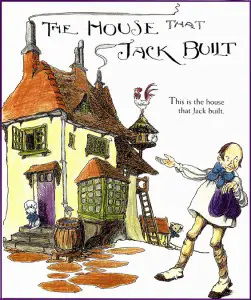 Anne Anderson’s House That Jack Built is worlds apart from a Victorian’s book plate, or Art Deco vision, or a Golden Book’s mid century idea of what the perfect abode would look like in Mother Goose Land. Because of these differences it’s like a birthday, or holiday whenever a collector finds a new version of a favorite title or genre. The anticipation when touching the dirty cracked boards of an intact unfaded cover illustration that’s enticing and promising something extraordinary, can be acute. So much so that when I open such a book and gaze upon the first example of the jewels within, I sometimes draw back air into my lungs, an involuntary reaction to tangible magic. Usually it only takes viewing one or two other plates to make me hug the book to my chest and walk quickly to the register, not to check out, but to put the prize in the safe hands of the proprietor, thereby keeping it from being whisked off by some interloper. And to protect it from my clumsiness. Inevitably I’ll be pulling books from stacks and the piece I’ve just found will slip from my reaching arms tumbling to an unforgiving floor, possibly damaging the brittle paper. And. . . . I want to save the savoring of the art until I can be at rest and give it my full admiring attention.
Anne Anderson’s House That Jack Built is worlds apart from a Victorian’s book plate, or Art Deco vision, or a Golden Book’s mid century idea of what the perfect abode would look like in Mother Goose Land. Because of these differences it’s like a birthday, or holiday whenever a collector finds a new version of a favorite title or genre. The anticipation when touching the dirty cracked boards of an intact unfaded cover illustration that’s enticing and promising something extraordinary, can be acute. So much so that when I open such a book and gaze upon the first example of the jewels within, I sometimes draw back air into my lungs, an involuntary reaction to tangible magic. Usually it only takes viewing one or two other plates to make me hug the book to my chest and walk quickly to the register, not to check out, but to put the prize in the safe hands of the proprietor, thereby keeping it from being whisked off by some interloper. And to protect it from my clumsiness. Inevitably I’ll be pulling books from stacks and the piece I’ve just found will slip from my reaching arms tumbling to an unforgiving floor, possibly damaging the brittle paper. And. . . . I want to save the savoring of the art until I can be at rest and give it my full admiring attention.
It’s an extraordinary day when a collector as such unearths several different versions of the title they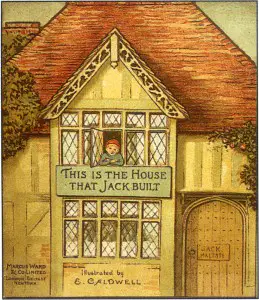 covet,and it’s happened to me once in a blue moon. Happening upon the best cover art I’ve yet seen, (I think this way for each and every new discovery) is a miracle. Stumbling across two, a divine intervention! For those who are not collectors, I’m at a loss of how to compare the experience to something that would ring true for you. Winning the lottery? Small, but still somewhat substantial sums? That’s the best I can relate–the elation over uncovering a new unexplored vision of my favorite books, is likewinning some prize, or my baseball team, the Phillies, winning a world series. Only happens every one hundred years–no,I correct myself, only 28 or 9 years have passed since the last celebration. But you get my drift, the rarity of the occasion makes the reaction to it even more acute, powerful, thrilling. Granted, I do
covet,and it’s happened to me once in a blue moon. Happening upon the best cover art I’ve yet seen, (I think this way for each and every new discovery) is a miracle. Stumbling across two, a divine intervention! For those who are not collectors, I’m at a loss of how to compare the experience to something that would ring true for you. Winning the lottery? Small, but still somewhat substantial sums? That’s the best I can relate–the elation over uncovering a new unexplored vision of my favorite books, is likewinning some prize, or my baseball team, the Phillies, winning a world series. Only happens every one hundred years–no,I correct myself, only 28 or 9 years have passed since the last celebration. But you get my drift, the rarity of the occasion makes the reaction to it even more acute, powerful, thrilling. Granted, I do 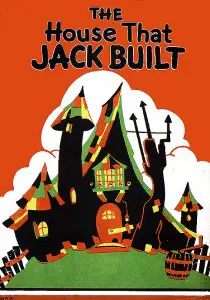 come across gems more often than the Fighting Phils win, but it FEELS as though it’s been forever since the last exquisite piece passed into my custody.
come across gems more often than the Fighting Phils win, but it FEELS as though it’s been forever since the last exquisite piece passed into my custody.
What is such a big deal about different artists drawing the same dumb story? Every artist has his or her creative inner eye, ogling the story or rhyme they need to express to the world. One artist may decide that it’s the Cow with the Crumpled Horn he wants to concentrate on, bringing out the most hilarious of images, with a dog flying off one twisted body part, about to land in a deep pool of mud. Another more delicate minded artist may decide she wants to focus on the wedding of the Maiden All Forlorn. Lace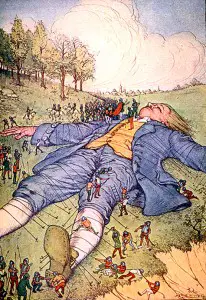 and ribbons and a dirty tattered man at her side saying their vows. A third artist is traditional in thought and builds the finest mansion seen in his minds eye. Each illustration brings a different viewpoint to the rhyme, a fresh eye, so the viewer also sees the rhyme in a new light, perhaps one not considered before.
and ribbons and a dirty tattered man at her side saying their vows. A third artist is traditional in thought and builds the finest mansion seen in his minds eye. Each illustration brings a different viewpoint to the rhyme, a fresh eye, so the viewer also sees the rhyme in a new light, perhaps one not considered before.
Naturally, most people would find collecting Mother Goose nursery rhymes a childish hobby. What’s the point? They’re for infants, kids to learn how to speak, read. And that’s true. The history behind the handed down sayings is vast, and fascinating. But I don’t linger on it. The rhymes themselves are interesting to dissect, but I don’t bother trying. No. My obsession is with the art, the lines and colors that a spirit and hands whipped up out of creamy air and set down on paper to delight the eye and senses. Practically no other piece of literature has more published versions each with an artist creating their own 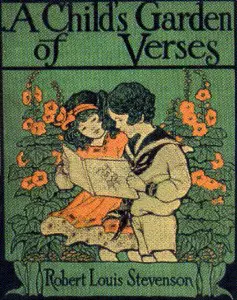 world of Mother Goose. Alice in Wonderland is another title I collect for various illustrators. Arabian Nights, Andersen’s and Grimm’s Fairy Tales probably come the closest to nursery rhymes in the number of different versions. Several people have taken their talents to Gulliver’s Travels–I have at least three–and I wasn’t consciously collecting it. Santa is terribly prolific, although rather similar, in most cases. Pirate stories, Peter Pan, The Wind in the Willows have been subjected to new insights with each generation, it seems. A Child’s Garden of Verses, has myriad’s of editions. In no attempt to collect the poems I find that I have a stack of them, probably because the best artists of the golden age of children’s illustration felt the need to put watercolor or ink to paper
world of Mother Goose. Alice in Wonderland is another title I collect for various illustrators. Arabian Nights, Andersen’s and Grimm’s Fairy Tales probably come the closest to nursery rhymes in the number of different versions. Several people have taken their talents to Gulliver’s Travels–I have at least three–and I wasn’t consciously collecting it. Santa is terribly prolific, although rather similar, in most cases. Pirate stories, Peter Pan, The Wind in the Willows have been subjected to new insights with each generation, it seems. A Child’s Garden of Verses, has myriad’s of editions. In no attempt to collect the poems I find that I have a stack of them, probably because the best artists of the golden age of children’s illustration felt the need to put watercolor or ink to paper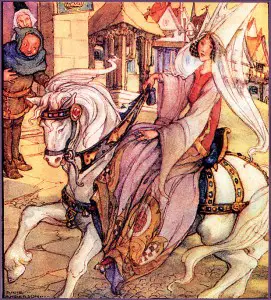 reflecting Robert Louis Stevenson’s sentimental view of childhood dreams.
reflecting Robert Louis Stevenson’s sentimental view of childhood dreams.
I don’t compare each style in an effort to decide which I like best. That would be impossible. Whereas Anne Anderson’s Rings on Her Fingers is sublime, and perhaps my favorite, along comes a completely unknown illustrator whose work was within the Victorian time frame, and is as fresh, sly, witty as if painted yesterday, and my entire assumption about what is ‘best’ goes beating its wings out the window. It doesn’t 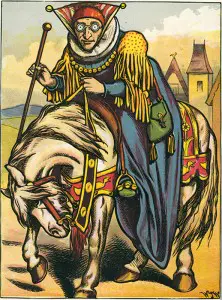 matter in the least if the artist whose book I picked up is famous, or uncredited. The art stands on its own, without the need for ceremony or critical praise. I have coveted the ability to see the way an artist does, to conjure up the perfect lines and shades that culminates in The Crooked Man, my favorite of all the rhymes. I so desperately would have loved to be talented enough to find a voice with pencils, charcoals, water colors, inks, oils, pens, and now acrylics. What a gift that would be! There must be such a indescribable joy to be had when the last blues are colored in on Miss Muffett, and the artist can sit back and
matter in the least if the artist whose book I picked up is famous, or uncredited. The art stands on its own, without the need for ceremony or critical praise. I have coveted the ability to see the way an artist does, to conjure up the perfect lines and shades that culminates in The Crooked Man, my favorite of all the rhymes. I so desperately would have loved to be talented enough to find a voice with pencils, charcoals, water colors, inks, oils, pens, and now acrylics. What a gift that would be! There must be such a indescribable joy to be had when the last blues are colored in on Miss Muffett, and the artist can sit back and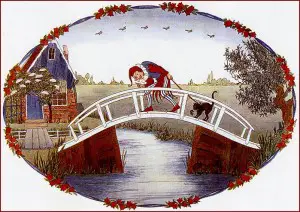 critically, as well as admiringly, study his finished work!
critically, as well as admiringly, study his finished work!
Sigh. Well, as no fairy god mother is going to tap me on the shoulder and give my fingers the ability to create such things, I am content to collect the offerings of others who were lucky enough to be born with the gift of showing the rest of us how dreams are made.
Illustrations:
Top left House that Jack Built—Anne Anderson
Top Right–E. Cauldwell
Middle Left–20s Artist–I need to find the info
Middle: Gulliver’s Travels–Milo Winter
Middle: A Child’s Garden Of Verses–Unknown (at least to me)
Rings on Her Fingers–
Bottom Right–Anne Anderson
Bottom Left–Victorian–Not credited
Bottom right: There Was a Crooked Man–H. Willebeek le Mair

I, too, love the illustrations in children’s books. My favorites are those done by the Dillons–such masterful art work!
Are they contemporary artists? I’m shamefaced to say I’m not familiar with them, but certainly would like to be! Thanks for commenting!
Diane
What a lovely round-up. I have a soft spot for different versions of Snow White and Alice in Wonderland –though the latter’s Tenniel illustrations can not be beat!
I’m an Alice fanatic–can’t get enough different illustrators, although, I agree, Tenniel will never be surpassed. Sometimes an illustrator can’t seem to get past the Tenniel look, and their work only echos his.
I have an entire collection of Alice illustrations on my flickr page
http://www.flickr.com/photos/picture-perfect-designs-jewelry/collections/72157615128651725/
and if you look around in Fairy Tales of Yore, I have several Snow Whites too.
The images used to be better in the old days. They used more harmonious forms and colors, tried to have kindness and love in their works. Today originality seems to be all what counts.